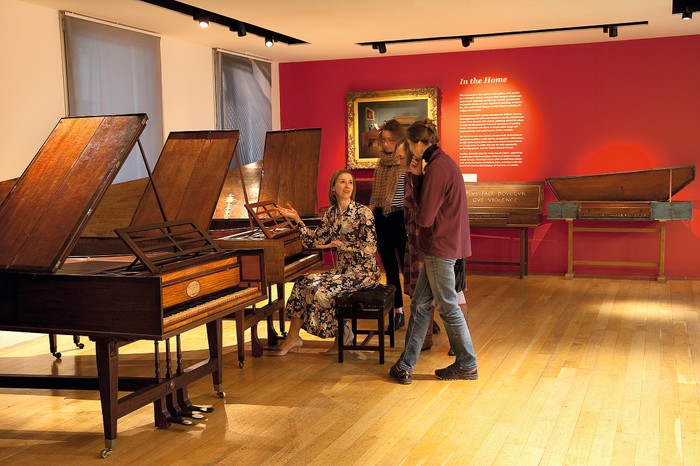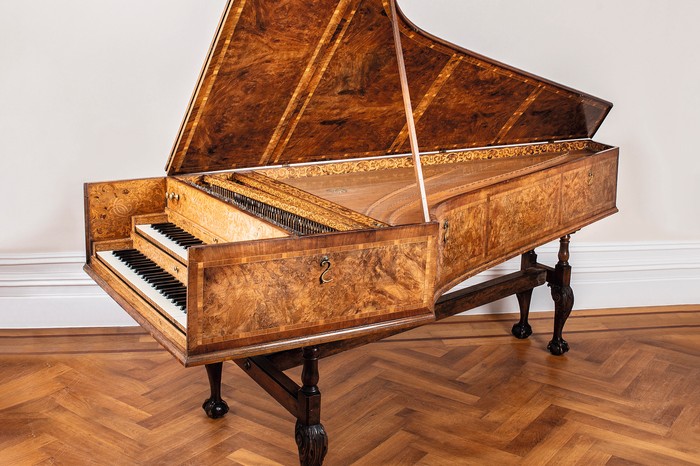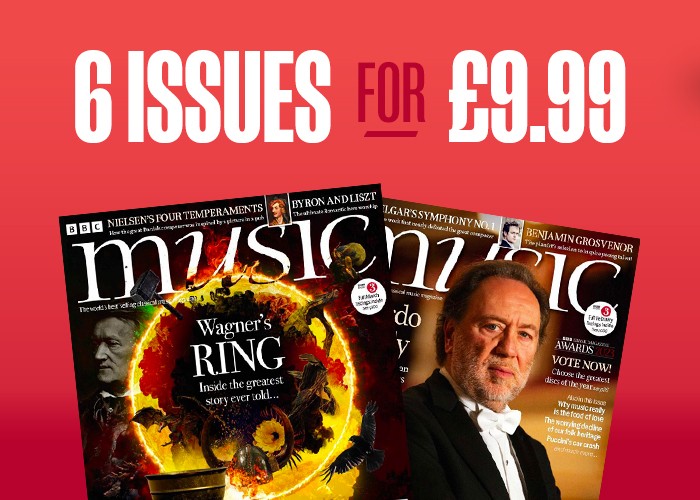Britain's best music museums: our most famous musical instrument collections
Andrew Green takes us on a tour of some of the UK’s best musical instrument museums and collections

Musical instruments are more than the mediums through which composers and performers express their talent.
They’re captivating objects in themselves, witness to another form of expertise – the consummate skill of the craftsperson. The UK’s abundance of musical instrument museums spells it out.
If you have plenty of time and, ideally, your own set of wheels, making a countrywide tour of these wonderful collections pays rich dividends. One inevitably finds oneself spending longer than anticipated lost in admiration of all manner of things plucked, struck or blown; plus, of course, there is often an expert or two around to provide a few extra nuggets of information. However, we live in the digital age, and most museums can also be browsed comprehensively online by those who cannot get there in person. So, it’s time to get the map out and – physically or virtually – plan a few visits…
Best music museums in London
Royal College of Music Museum
First stop, a sight of the just-redeveloped Royal College of Music Museum in South Kensington. This traces its origins to 1894, when the initial collection amounted to around 250 instruments, as curator Gabriele Rossi Rognoni explains during my guided tour. ‘Now there are 15,000 examples, mostly in storage. We offer a whole history of musical creativity seen through instruments.’
The permanent collection offers a feast for the eyes wherever you look. Perfectly lit display cases host a range of stringed instruments for bowing or plucking from a wide historical span (including the earliest surviving guitar) but with elegant recorders and other woodwind instruments in the mix.
Dominating the space, though, is an array of keyboard instruments. You’ll want to see the earliest surviving stringed keyboard instrument — a clavicytherium from around 1480. Rognoni himself singles out a gorgeously decorated mid-16th-century harpsichord made in Venice by Alessandro Trasuntino. I go for domestic simplicity – an unassuming yet handsome 1685 spinet, made in London by Stephen Keane.
A special, free exhibition, Music, Migration and Mobility - The Story of Émigré Musicians from Nazi Europe in Britain, runs from 17 January until 16 April 2023.
Horniman Museum
Next stop, Forest Hill SE23, for the astonishingly variegated assemblage of 1,300 musical instruments gracing the Horniman Museum. Established in 1901 by Frederick Horniman as a repository for his various acquisitions – embracing natural history, cultural artefacts and musical instruments – the museum continues to offer free entry to all-comers, as its founder intended. ‘The collection invites visitors to celebrate diversity, whatever the musical genre,’ says Mimi Waitzman, the museum’s senior curator of Musical Collections and Cultures.
And so much of humanity is here in this magical space. I find myself whisked through much familiar territory in terms of Western classical and popular music (including an extensive display of brass instruments and an electric guitar enclave) then on to a cornucopia of exhibits from the Far East and Africa.
More like this
I adore the beauty of a harp-lute from Senegal and a lyre from Ethiopia, but also savour the characterful charm of a group of pottery ocarinas and a cluster of lamellaphones – again, African – whose metal tongues attached to boards are plucked with fingers/thumbs. A select range of instruments can be heard in recordings to hand.
Musical Museum
Still in Greater London, the Musical Museum in Brentford puts the accent on musical reproduction, from miniature music boxes and self-playing violins to reproducing pianos (using rolls as the recorded medium) and orchestrions (machines mimicking an orchestra or band) – plus, of course, dips into the story of the gramophone. It’s all the brainchild of Frank Holland, a collector of reproducing pianos, over half a century ago.
‘We now have items manufactured across a span of around four centuries,’ says Steve Barrett-White, chair of the museum’s board of trustees. There’s no shortage of things to hear in action, representing many musical genres, classical included – and it’s clearly great for kids.
The choicest item for Barrett-White is the Mighty Wurlitzer theatre organ, manufactured in New York in 1928. ‘This was commissioned by a wealthy Chicago resident who then suffered in the Wall Street crash, so the instrument had to be warehoused.
It found its way to the Regal cinema in Kingston! The BBC’s The Organist Entertains radio programme used to feature it.’ (On similar lines, incidentally, try also the Grange Musical Collection (grangemusicalcollection.com) of self-playing instruments at Diss in Norfolk – fabulous machines of all sizes…and shapes!)
The V&A
While you’re in the capital, you’ll also want to pop into The V&A, which houses a glorious collection of instruments chosen for their aesthetic beauty.
The Museum of the Royal Academy of Music

The Museum of the Royal Academy of Music , meanwhile, has been collecting instruments, scores and memorabilia since its foundation in 1822
The British Museum
The British Museum (britishmuseum.org) carries a renowned collection of musical instruments from around the world, dating back through millennia.
National Trust’s Fenton House
And in Hampstead, the National Trust’s Fenton House is home to the Benton Fletcher Collection of early keyboard instruments, all in playing condition.
Best music museum in Surrey
National Trust’s Hatchlands Park
Driving to the National Trust’s Hatchlands Park property near Guildford always stirs excitement at the prospect of feasting the eyes on the keyboard instruments in Alec Cobbe’s peerless Cobbe Collection.
The USP is their special connection to composers. Instruments from a range of European makers link to the likes of Purcell and Elgar; Mozart, Haydn and Beethoven; Chopin and Mahler; Liszt and Bizet. This isn’t a collection that stands on ceremony, shrouded in silence.
Examples feature in the regular series of Hatchlands concerts, and everyday visitors can hear the sound of each instrument via an audio guide. ‘The articles of the collection’s charitable trust stipulate that the instruments must be kept in playing order and used,’ explains Cobbe.
See Elgar’s Broadwood piano which enabled the sketching of such works as The Dream of Gerontius and the Enigma Variations; the Jean Roller combined piano/composing table on which Bizet penned his opera Carmen; and Johann Christian Bach’s Zumpe & Buntebart 1770s piano, very likely used by Bach’s friend Mozart for the first performance of the latter’s formidable A minor Sonata, K310.
‘Imagine being able to hear that sonata played here at Hatchlands on a range of instruments manufactured in Mozart’s lifetime!’ says Cobbe. ‘Each offers something completely different.’
Best music museum in Kent
Waterdown House in Tunbridge Wells

Talking of historic keyboards, the 2015 closure of the Finchcocks Musical Museum at Goudhurst, Kent meant the sale of most of fortepianist Richard Burnett’s extraordinary collection of historical keyboard instruments. The good news is that 14 classic examples – dating from 1700 to 1824 – remain accessible via the Richard Burnett Heritage Collection at Waterdown House in Tunbridge Wells. Viewings are by appointment, and there are special events and concerts.
Best music museum in Oxford
Oxford University’s Bate Collection
On my latest visit to Oxford University’s Bate Collection, unassumingly tucked away south of the city centre, I’m greeted with news that this remarkable repository transfers to purpose-built premises in north-central Oxford in a few years’ time. Perhaps then it will get the visitors it deserves. The collection bears the name of the late Philip Bate, a cash-strapped BBC producer who developed a passion for picking up historical instruments as bargains from market stalls and junk shops.
The collection has developed across a broad range of instrument types which threatens to burst these modest quarters at the seams. Rank upon rank of wind instruments, for example, highlight any number of adaptations in design. The eye is drawn to the serpent (forerunner of the trombone) which may have been played at the Battle of Waterloo.
However, my personal favourite is a clutch of 18th-century clarinets d’amour – for sheer looks. And pop to the upstairs gallery for a surprise: two Afghan lutes – a rabab and a shash tar – donated by US Army colonel Frederick E Carl, who rescued them while on active service in Afghanistan. ‘Without his intervention, the instruments would have been destroyed by the Taliban,’ notes the Collection’s curator, Andy Lamb.
Pitt-Rivers Museum
Before leaving Oxford, maybe take in the musical instrument holdings at the Ashmolean (ashmolean.org/musical-instruments) and the even more extensive one at the Pitt-Rivers Museum.
Best music museum in Manchester
Royal Northern College of Music
Public access to the Royal Northern College of Music’s Collection of Historic Musical Instruments is restricted, though every instrument (around 300 all told) can be viewed online. Familiar European instruments rub shoulders with items from around the globe – Cameroon and Dahomey, Bengal and New Guinea, China and Japan, Ecuador and Tibet. Star pick: an exquisite silk-stringed Japanese kokū with narrow elongated fingerboard.
Best music museum in Edinburgh
University of Edinburgh
None of these collections traces its origins further back than the one owned by the University of Edinburgh. Professor John Donaldson assembled some 200 instruments in the mid-19th century, and an active collecting strategy instigated in the 1950s means that over 6,000 instruments are now held.
At its St Cecilia’s Hall home, the archive includes a number of acquired collections – including percussion instruments once owned by legendary player James Blades, and what is said to be the largest collection of clarinets in the world, assembled by eminent geologist/amateur clarinettist Nicholas Shackleton.
‘You don’t need to be a musical expert to enjoy seeing and learning about the 400 musical instruments on display,’ says Cecilia’s Hall curator Sarah Deters. Among the exhibits she singles out are a 1594 tenor trombone by Anton Schnitzer of Nuremberg, one of the oldest playable trombones in the world, and a Chinese tam-tam once owned by the afore-mentioned Blades. ‘He used it to record the three gong strokes heard in the introduction frames for General Film Distributors films in the 1930s,’ says Deters.
Best music museum in Glasgow
Glasgow’s National Piping Centre
Classical composers rarely embrace bagpipes (Peter Maxwell Davies’s An Orkney Wedding, with Sunrise is a rare example). However, prepare to be bewitched at Glasgow’s National Piping Centre (thepipingcentre.co.uk) which imaginatively promotes playing and incorporates a fascinating Museum of Piping, smartly designed and endlessly informative.
There aren’t just Highland bagpipes on show, says the centre’s Jamie Curran. ‘There are also Northumbrian pipes and other examples from around the world. Our earliest example of Highland pipes is believed to date from the time of the Battle of Culloden in the mid-18th century. And we have a set of 3D-printed pipes!’
Best music museum in Northumberland
Talking of Northumbrian pipes, you’ll find plenty more at the Morpeth Chantry Bagpipe Museum in Northumberland itself.
‘They’re chamber music instruments, making a more intimate sound than Highland bagpipes,’ museum curator Anne Moore explains. Overall, more than a hundred sets of bagpipes take you as far afield as France, Italy, Spain and Estonia. ‘Bagpipes are found across Europe, Asia Minor and in Africa,’ says Moore. ‘No one knows where they originated.’
Main image: Horniman Museum © Ludovic des cognets




